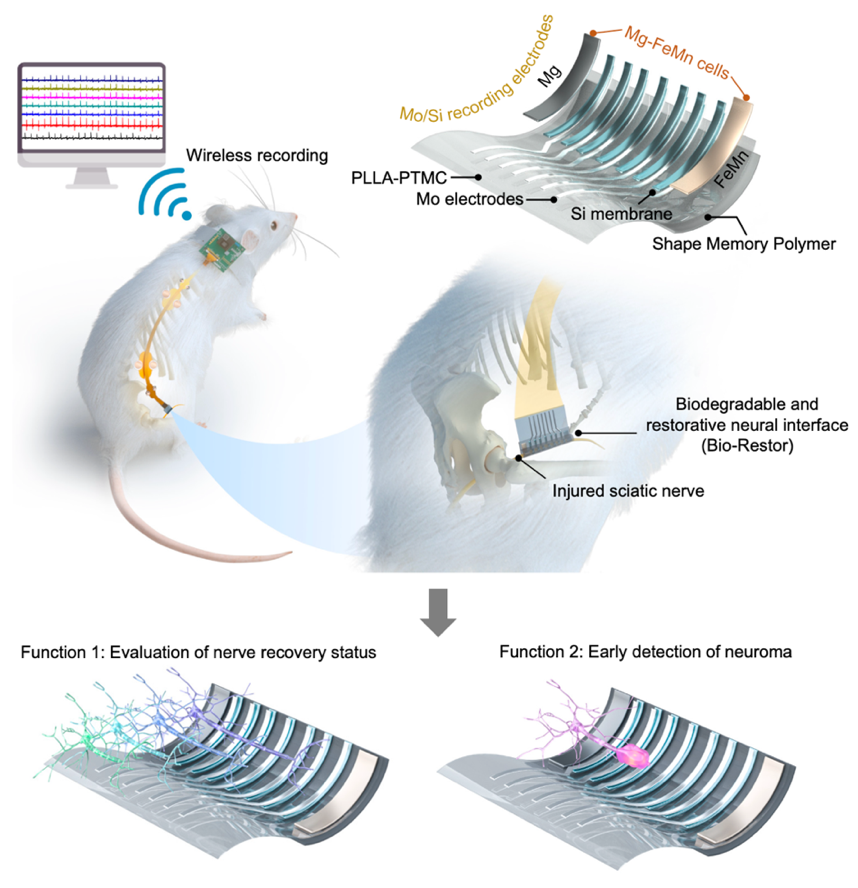On February 18, 2025, Professor Fan Yubo's team from the School of Biological Science and Medical Engineering at Beihang University published a research paper titled “A biodegradable and restorative peripheral neural interface for the interrogation of neuropathic injuries” in Nature Communications. The research introduces a novel biodegradable neural interface (Bio-Restor) that enables real-time monitoring and repair of peripheral nerve injuries, offering a significant advancement in the early diagnosis and treatment of neuromas.
The co-corresponding authors include Professors Fan Yubo and Wang Lizhen from Beihang University, Associate Professors Yin Lan and Zhang Milin from Tsinghua University, and Associate Researcher Wang Yu from the Chinese PLA General Hospital. The co-first authors are Assistant Professor Wang Liu from Beihang University, Dr. Zhang Tieyuan from the Institute of Orthopedics, Dr. Lei Jiaxin from Tsinghua University, and Dr. Wang Shirong from MegaRobo Technologies. Beihang University is the primary affiliation responsible for this work.
Peripheral nerve injuries are a common clinical issue, and achieving effective nerve repair with real-time monitoring during the early recovery phase is crucial for optimal therapeutic outcomes. Although traditional implantable electrical stimulation devices for nerve repair can promote nerve regeneration, their non-degradable design and lack of real-time in vivo monitoring capabilities significantly limit their clinical applications.
In the research, the authors present a biodegradable and restorative neural interface (Bio-Restor) designed for concurrent monitoring and facilitating the healing of long-gap nerve injuries at a finite time frame matched to the critical initial phase of nerve recovery. Experimental results show that this interface not only significantly promotes the repair of sciatic nerve defects in rats through electrical stimulation but also allows for wireless real-time acquisition of neural signals, enabling in vivo assessment of nerve regeneration length and providing real-time monitoring tools for the nerve repair process.

Biodegradable and restorative neural interface (Bio-Restor) for wireless interrogation of neuropathic injuries
Employing machine learning techniques, the researchers developed a quantitative correlation model between electrophysiological signal features and gait parameters collected from experimental animals. This provides reliable metrics for objectively assessing nerve function restoration. The study leverages the fact that nerve injury and regeneration alter motor neuron firing patterns, leading to systematic changes in gait kinematics (e.g., joint angles) and spatiotemporal parameters (e.g., stride length, stance phase, and swing phase duration).

Evaluation of nerve recovery status using Bio-Restor

Machine learning assisted evaluation of nerve recovery status through the analysis of swing phase based on recorded electrical signals
The neural interface can also identify abnormal regenerative neuromas at an early stage, achieving 94% accuracy—one week earlier than traditional ultrasound diagnostic methods. This early detection enables timely intervention, significantly improving treatment outcomes.

Early detection of neuroma using Bio-Restor
A key innovation of the Bio-Restor interface is its construction from biodegradable materials, eliminating the need for secondary surgeries to remove the device. This reduces the risk of infection and secondary tissue damage. The interface demonstrated excellent biocompatibility, with no significant adverse reactions observed in vital organs such as the heart, liver, spleen, lungs, and kidneys during the degradation process.

Biodegradable and biocompatible characteristics of Bio-Restor
In summary, this study develops a dual-functional biodegradable neural interface capable of both nerve repair and real-time monitoring. It not only effectively promotes nerve regeneration but also tracks axonal growth length and gait parameters during recovery. Its ability to detect abnormal neuromas early provides critical support for timely clinical intervention and optimized treatment outcomes.
This work was supported by the National Natural Science Foundation of China, Beijing Municipal Natural Science Foundation, Beijing Nova Program, and Fundamental Research Funds for the Central Universities.
Link to the original article: https://www.nature.com/articles/s41467-025-56089-1
Editor: Han Xu

